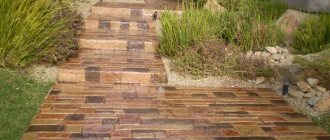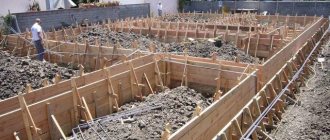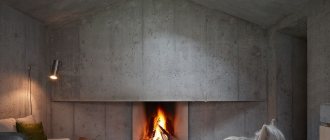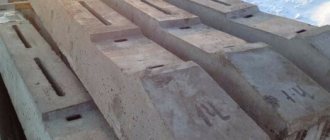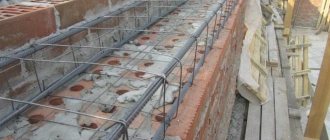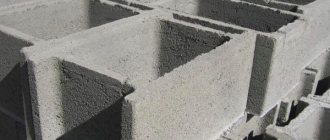For hundreds of years, concrete has been one of the most common types of building materials for the construction of structures of any purpose and size. Foundations, frames, supporting and enclosing structures, fences, and even roads are made from it. At the same time, builders most often give preference to concrete grade M300.
Concrete mortar grade M300 with the correct ratio of components can be ordered on the website “Concrete 174”
After all, this material not only has sufficient strength to perform most tasks, but also sets quickly and is relatively inexpensive. Compliance with the proportion of concrete M 300 is the main requirement in its production; many other parameters depend on this indicator.
Main components of M300 concrete
To obtain high-quality concrete with strength M300, add the following to the solution:
- cement M400 or M500;
- water, which should not contain any impurities and, especially, oils;
- sand (preferably clean, coarse and without impurities);
- filler, which is most often used granite and crushed gravel;
- various additives.
The choice of granite crushed stone leads to an increase in the strength of concrete compared to the use of gravel material, however, it also increases the overall cost of the work. Although, in general, the use of sand and crushed stone in the composition, on the contrary, leads to a reduction in its price, creating a structural frame that softens the load on concrete structures. Accordingly, the need to use large amounts of cement is reduced.
In order to obtain the maximum strength of M300 concrete, the proportions of its components (by weight) should be as follows:
| Type of cement | Share of relevant material | |||
| Cement | Sand | Crushed stone | Water | |
| M400 | 1 | 1,9 | 3,7 | 0,5 |
| M500 | 1 | 2,2 | 3,7 | 0,5 |
It is in this ratio that the materials are mixed in a concrete mixer using vibration to avoid the appearance of air bubbles in the concrete. It is worth noting that the amount of water to obtain the composition is approximate and depends, first of all, on the quality of the sand and crushed stone used. As a result, to obtain 1 cu. m of concrete requires about 350 kg of cement, approximately 800 kg of sand, up to a ton of crushed stone and at least 200 liters of water. The mass of other additives usually does not exceed 10 kg per cubic meter.
Technical characteristics of concrete
In accordance with the degree of strength, classes (B10, B15) and brands (M200, M300, M400, etc.) are distinguished. The higher the numbers next to both indices, the more durable and resistant to various loads the concrete is. It is the class and brand that determine the scope of application of the material. Any table indicates the proportions of concrete based on brand and class.
Typically, these two indicators interact with each other (the corresponding class corresponds to a specific brand). In design documentation, the brand is most often indicated, and in various types of instructions, specifications, classes are indicated.
Compliance of the grade with the use of concrete
Concrete solutions of different brands are used in certain areas, for certain structures, objects, buildings. So, for example, the composition of M400 concrete is not relevant for making footings or rough screeds (it will be expensive, and the technical characteristics of the mixture are simply not needed). While M100 concrete is not suitable for hydraulic structures.
The table below shows the correspondence of concrete grades to the area of use:
Experts do not recommend changing the grade of concrete specified in the project or simply corresponding to the type of work to another, either downward or upward. A lower grade of concrete means less strength and resistance to various influences, which can lead to rapid deformation of the monolith, the appearance of cracks, and complete destruction of the structure due to the inability to withstand the imposed loads.
On the other hand, hoping for a higher quality of a building or element, sometimes they prepare a solution of a higher grade, which is completely unjustified from a financial point of view. Thus, the composition of concrete M200 involves the use of cement of a certain brand and in the required volume, fillers of suitable fractions and quality.
If you take more expensive cement in larger quantities, spend money on high-quality filler (which is not required according to the recipe), the concrete monolith will turn out to be more durable and resistant. But the scope of application will not allow using all these indicators to the maximum and preparing the material will simply result in unjustified expenses.
Different grades of concrete correspond to the type of work, operating conditions, expected loads, climatic conditions and a host of other factors that must be taken into account when choosing the optimal composition and grade of mortar.
Main components of concrete mixture
To obtain a recipe for preparing concrete mortar, it is best to use tables - they indicate how many and what components need to be taken per 1 cubic meter of mortar. So, for example, for M200 concrete per 1 cubic meter you need less cement (and possibly a lower grade) than in the case of preparing M400 concrete per 1 m3.
In addition to proportion, it is important to study both general and specific requirements for materials. Specific ones relate to the exact size (fraction) of filler, brand of cement, etc. The general ones apply to all types of cement mortar and are taken into account regardless of whether the cement is prepared at the factory or at the site with your own hands.
Requirements for concrete mortar components:
- Cement - must be produced as close as possible to the date of preparation of the solution. It is better if less than 3-4 months ago, otherwise the cement has probably already lost some of its strength (subject to proper storage). If the material was stored incorrectly, there may be lumps in it that will not return to their original state and will significantly deteriorate the quality of the solution. It is better to buy cement immediately before use from a trusted manufacturer or supplier, making sure to check the date of manufacture. The water is fresh, without impurities (after thorough purification). Many masters ignore this component, believing that any water can be used, but this is not so. The quality of the mixture largely depends on this component, which is responsible for the setting and hardening reaction. Sand must be purified, without any impurities (clay is especially dangerous, which impairs adhesion properties), white or gray in color (but not yellow, which indicates the presence of clay in the material). Crushed stone is clean, without additional inclusions, small debris and dust. It is desirable that it be granite crushed stone. Gravel or limestone may also be suitable, but granite is considered a better choice due to its high frost resistance and low water absorption. Additional additives are introduced to change for the better certain characteristics of a concrete mixture or an already hardened monolith: plasticizers improve plasticity and make the material more comfortable to work with, hydraulic seals protect against high humidity, anti-freeze additives make it possible to work at sub-zero temperatures, dust removers increase the strength of raw materials and reduce its abrasion properties and hardening retarders prolong the hardening time of the mixture.
Currently reading: Application of M450 concrete
Cement and water are the main binding components in the solution, therefore they are considered the main components. It is very important to correctly take into account the ratio of cement to water in accordance with the moisture level of fine and coarse aggregates. The absorption capacity also depends on the type of components. It is very difficult to calculate all this on your own, so it is easier to look in the table to see how much and what should be contained in one cube of concrete of a certain brand.
Small and large fillers create a structural framework for concrete and the future monolith, which ensures the required strength indicators. Fillers are also needed to reduce the risk of deformation and resistance to various loads and impacts.
Material consumption: table, proportions of concrete per 1m3
To prepare a cube of concrete, it is important to know what brand of mixture is needed to perform a specific task, and then look at the proportions and requirements for the components in the table. Below are the tables - in them you can find both the components for the M100 mixture and the composition of M300 concrete per 1m3 (the table provides information on the most common brands):
A standard concrete mixture, which is often used in private construction for pouring foundations, monolithic floors, etc., assumes the following proportions: 0.5 parts water, 1 part cement, 2 parts sand, 4 parts crushed stone.
Important factors to consider when choosing a proportion:
- The method of laying the mortar into the formwork is using construction equipment or on your own. If you do it yourself, then the composition should be plastic; if you use technology, the mixture can be more dense. Budget - materials for preparing concrete cost a lot, so you need to find a balance between the desired quality and cost, for basic work (foundation, floors, etc.) selecting mixtures of high grades, and for unloaded structures and work where strength is not so important, preparing a solution of a lower class. The type of structure being built, operating conditions - in many cases, the design grade of concrete is increased due to soil instability, some individual requirements and features.
Below are the proportions of concrete for mixing mortar grades M100, M200, M300, M400:
It turns out that if you need to prepare concrete (1 m3) of grade M200, then take 1 part of cement of grade M400, 2.7 parts of sand, 4.9 parts of crushed stone. At the same time, if you take M500 cement to prepare a solution of the same brand M200, the proportions are already different: for 1 part of cement you will need 3.5 parts of sand and 5.2 parts of crushed stone. Other ratios work for other brands of concrete mortar.
To obtain data in buckets, it is enough to know the density of the materials. So, one bucket with a capacity of 10 liters will weigh 12 kilograms of cement (10 x 1200, since the bulk density of cement is 1200 kg/m3), 14 kilograms of sand (density 1400 kg/m3), 15 kilograms of gravel, etc. It is enough to simply divide the taken number of kilograms in proportion to the number of kilograms that fit in the bucket and measure everything with this container.
Proportions of concrete composition for the foundation
When choosing the ratio of components for preparing a solution for pouring the foundation, no special values are taken. It’s just that for the foundation and other critical (loaded) structures they choose high-grade concrete - at least M300, or even M400, M500. The mixture is prepared according to the usual algorithm, strictly observing the proportions in accordance with the table.
Parameters of concrete M300
The main parameters of concrete grade M300 include the following values:
| Characteristic name | Parameter value | Note |
| Strength class | B22.5 | The value is conditional, and with the help of additives it can be increased to B25. |
| Compressive strength | 295 kgf/cm2 | |
| Waterproof | W6 | |
| Frost resistance degree | F200 | The ability of concrete to freeze and thaw during operation at least 200 times. |
| Mobility category | P2 – P4 | Depends on the conditions of concrete use. |
The relatively low frost resistance of concrete, which is inferior to that of a number of other building materials, is optimally combined with the water resistance of W6. And, since resistance to freezing and thawing is established in relation to solutions saturated with liquid, even the F200 indicator is quite sufficient. While the water resistance rating ensures the use of concrete even for swimming pools, a 150 mm slab is enough to withstand a layer of water 50–60 m thick.
The strength indicator indicates that M300 concrete can withstand pressure of almost 300 atmospheres. And the mobility of class P2–P4 indicates the possibility of pouring into any shape. Subsidence of such concrete occurs under the influence of its own weight, and the material easily fills all cavities.
Special parameters
If a construction project will be operated under special conditions, then special requirements will be imposed on it. This may be frost resistance or moisture resistance, strength or long-term operation under high wind loads, resistance to constant exposure to mineral salts or aggressive chemical environments. To fulfill these conditions, various additives are added to concrete. Concrete for special purposes is also prepared - exposure classes XD, XF, XM, XA. Additives improve certain material parameters, increasing the quality of the final product.
To improve the plasticity of concrete, there are also certain plasticizers. Most often they are used in compositions that are poured into reinforced formwork or with which a reinforcing metal mesh is laid. The plasticizer helps to distribute more evenly throughout the formwork, completely squeezing air out of difficult areas.
Types of heavy concrete
Stabilizers are also offered that increase the degree of resistance of the base of a construction project to erosion by groundwater or precipitation. This building material is called waterproof. The absence of this kind of additives negatively affects the stability of concrete with a compacted consistency when used in waterlogged soil, while the walls of the facility are built up to 0.4 meters thick. Such conditions should be met so that the moisture diffusion is ≤ 0.6, and for thicker walls - 0.7.
Fillers for 1 m3 of concrete
Portland cement and industrial pure water help to create a monolithic structure, just like how a feast of interaction forms a cement stone. But after hardening, the stone can be deformed, and the foundation shrinkage values can reach 2 mm/m.
Weight and volume ratio of aggregates in concrete
To make 1 m3 of good concrete, you need to take the amount of bulk substances indicated in the figure above. To avoid mistakes, professionals recommend doing a small test batch. If the sand is wet, add less water to the solution than recommended. Based on the information above, preparing concrete of any purpose and quality yourself does not present any particular difficulties.
Material hardening conditions
The hardening process of M300 concrete solution with correctly selected proportions is accompanied by chemical reactions with the formation of crystalline hydrates. In this case, the cement interacts with the liquid and the formation of new materials. If there is not enough water, hardening will slow down and strength will decrease. Sometimes in this case cracks and shrinkage of concrete appear. Therefore, the composition should harden only under certain conditions, which are created and maintained by the performers of the work.
You can prevent cracking of the concrete surface by covering it with burlap or filling it with sand. At high ambient temperatures, concrete moistening should begin no later than 2 hours after completion of concrete work. Under normal temperature conditions, this period increases to 12 hours.
Humidification Features:
- sprayers are used to saturate the material with moisture;
- the frequency of moisturizing depends on the temperature: in hot weather - a couple of hours, the rest of the time - as it dries;
- the nodes and edges of the structure require more careful processing;
- humidification is stopped if the temperature drops below +5°C;
In addition to saturation with moisture, concrete must be protected from erosion by precipitation, shock and mechanical damage. Contact of aggressive liquids with the composition that has not completely hardened is not allowed. And people can walk on concrete no earlier than its strength reaches at least 15 kgf/cm2.
Features of application
The proportion of the concrete solution is an important factor, taking into account which a high quality material is obtained. At the same time, other rules should be followed to simplify the work and reduce concrete consumption:
- when choosing crushed stone, they give preference to one whose strength is approximately twice that of the concrete grade - in this case, 600 kgf/cm2. This makes it possible to reduce the deformation of the structure when the solution hardens and gains strength (on average, about six months);
- Limestone grade 500 or 600, and even gravel with a density of 800–1000 kgf/cm2 can be used as a filler for this concrete;
- the diameter of the crushed stone grain should not exceed 50 mm. The best option is fractions measuring 5–20 mm.
When mixing the composition, ensure complete absorption of water. This homogeneous mixture is best obtained by using a concrete mixer. However, if the proportions of the components of M300 concrete are chosen incorrectly, regardless of the quality of mixing, voids may appear in the material. And this will worsen the performance characteristics of the concrete structure and lead to their destruction ahead of schedule.
Concrete for strip base
A strip foundation requires precise calculations - it is too expensive in private construction. Beginning of calculations - the geometric dimensions of the tape (length, width, depth) are multiplied by the number of tapes in the foundation.
With a length of 20 meters, a width of 50 centimeters and a depth of 1 meter, 10 m3 of concrete slurry will be required. 20 x 0.5 x 1 = 10.
After preparing this volume, the solution is poured layer by layer into the prepared formwork. The thickness of the layers is no more than 0.25 meters. Each layer is compacted with a crowbar or shovel to expel air from the solution. You can also tamp with a deep vibrator if you have one.
Calculation of strip foundation
